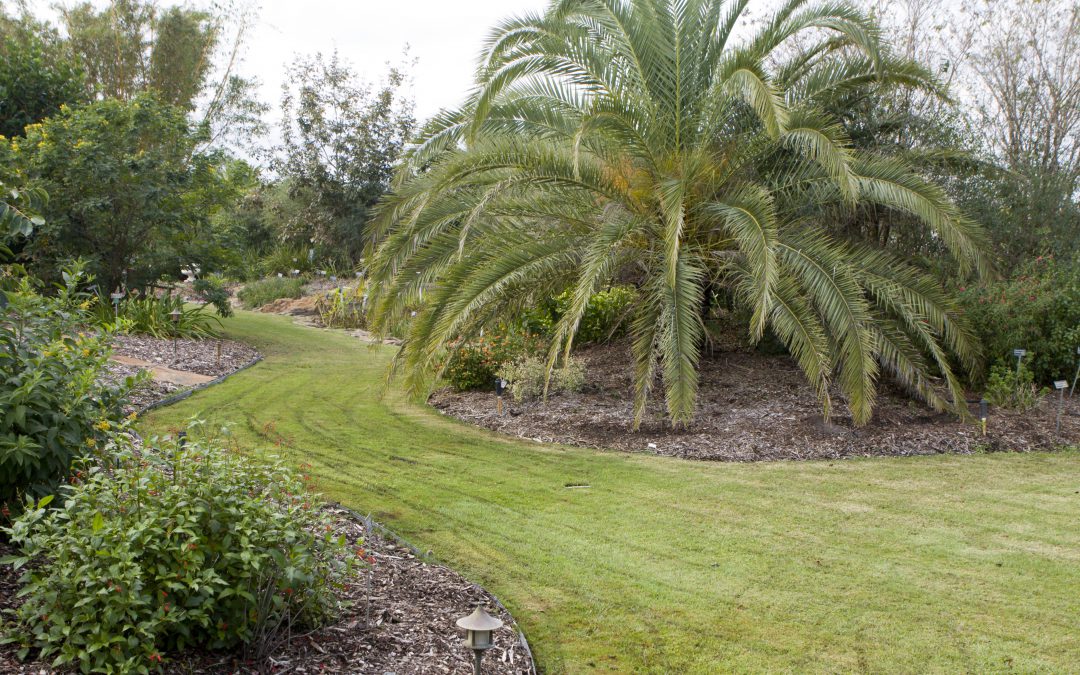
by Joshua Criss | Apr 20, 2022
Getting your landscape set up in the spring is an in-depth process. Trees are pruned, soil amended, and the plantings have been accomplished. Now you have exactly the look you want. It would be easy to sit back, open a beverage of your choice, and watch it all come together. Don’t get comfortable just yet, there is a group of pests eyeing your plants. Insects come in many forms, looking to make a meal from your hard work. Do not fear though, there is a straightforward way to protect yourself from these creatures. Integrated pest management is a system of four control approaches designed to mitigate pest damage while minimizing impact on the environment.
Identification is Key
Before any of these steps may begin pests must be identified. This starts with scouting your landscape via visual inspection. Insects leave signs of their presence wherever they visit. Be sure to inspect every part of your plants including the underside of leaves. Here is where you will find insect eggs or frass (excrement) which are tell-tale signs of activity. Once discovered, you need to identify your specific pest. Insects are identified by their mouth parts when assessing plant damage. Chewing insects remove leaf material (think caterpillars and grasshoppers). Speckled leaves of brown and yellow is a symptom of piercing/sucking insects such as aphids. Other times you may only find damage after the fact where black leaves turn out to be covered in sooty mold. The sooty mold grows on the excreted honeydew of aphids, whiteflies. Once identified, it is up to you to decide if the level of damage is worth it and how you would like to approach limiting the damage.
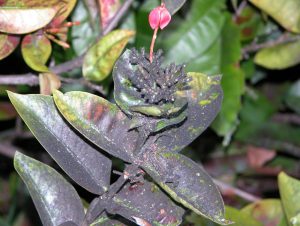
Sooty mold on Ixora Photo Credits: UF/IFAS Kim Gabel
The First Three
The first strategy is cultural control wherein you optimize the environment in which your plant grows. Improved drainage and removal of plants susceptible to insect attack are excellent examples. You should also look into the lifecycle of insect pests to remove anything that will provide habitat. The next control is mechanical. This methodology is the most work intensive but comes with the least environmental impact as insects will be removed by hand. Biological control is like mechanical control except that removal of the pest is left to natural predators. There are many, but birds and lady beetles are best known. Creating habitat for these will help keep insect populations to an acceptable level with the bonus of falling into Florida friendly landscaping philosophies.
Chemicals are Not the Bad Guy
Chemical control is the final approach. Some may be surprised to find this here, but it is effective. With the above in place, you may find there are still insect issues. Chemicals will be your next step but do not feel put off by this approach. Research the best products for your situation and follow the instructions on the label to the letter. The label is designed to reduce risk to you and the environment while providing effective pest control.
Insect pests have plagued gardeners since the first person intentionally planted anything. Controlling these pests using a multipronged approach is the optimal way to reduce damage to your plants while minimizing environmental impact. Following the methodology in this post will bring a pest free landscape that you and your family will enjoy. For more information on integrated pest management, see these Ask IFAS documents, or contact your local extension agent for additional information on this and any topic regarding your gardens and more.
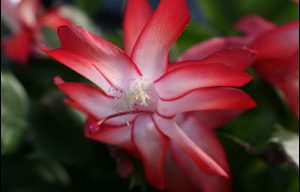
by Matt Lollar | Nov 22, 2021
Houseplants can soften up the interior of your home and help clean the air. They can also supplement your holiday decorations and help create stunning focal points. To help determine what plants do best under certain conditions and to give pointers on plant care, this month’s Gardening in the Panhandle LIVE! was all about houseplants.
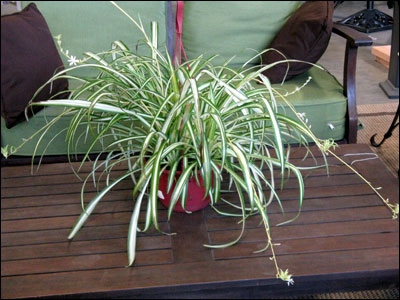
A spider plant on a coffee table. Photo Credit: University of Florida/IFAS
Environmental Conditions for Houseplants
Unless you live in a glass house, you’ll probably want to choose houseplants that do well in low light conditions. A guide for what light level different houseplants prefer can be found on the Gardening Solutions Light for Houseplants page. This page also provides useful tips on supplemental lighting.
Some houseplants are better at cleaning the air than others. A list of houseplants that do a good job improving indoor air quality can be found on the Gardening Solutions Houseplants That Clean the Air page.
The best way to determine if your houseplants need water is your own green thumb or whatever finger you choose to stick in the potting mix, but for some interesting information on outdoor soil moisture meters check out this informative publication on soil moisture sensors.
Houseplants need a good quality, well-drained potting mix to thrive. Tips on selecting a potting mix can be found on the Gardening Solutions Container Media page.
Houseplant Pests
One of the best ways to rid houseplants of insect pests is to set the plants outside for a few days and let the pests move on. For some information on pest control products in and around the home check out the publication Natural Products for Managing Landscape and Garden Pests in Florida.
Fungus gnats are mainly a nuisance, but some species can feed on living plant tissue. Darkwinged fungus gnats are known to feed on ferns, orchids, and geraniums.
Houseplant Propagation
One way to increase your houseplant population and save a few dollars is to propagate your own plants. The University of Florida/IFAS created the Plant Propagation Glossary to help with any propagation questions you may have.
Air layering is a propagation technique that not only allows the prospective plant to thrive from the nutrients of the mother plant, but it also saves space.
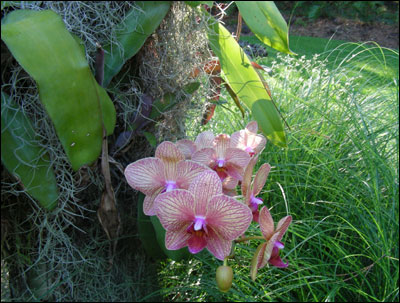
A moth orchid (Phalaenopsis spp.) outdoors. Photo Credit: University of Florida/IFAS
Specific Species Info
Orchids in the genus Phalaenopsis are easier to care for than other genera of orchids. The American Orchid Society provides some great tips on caring for orchids indoors. Some people choose to water their orchids with ice cubes. The Ohio State University has a publication that provides some more insight on watering Phalaenopsis orchids with ice cubes.
A lot of cacti do well indoors. A popular cactus during the holiday season is Christmas cactus. Christmas cactus have interesting foliage, but their blooms are what people want to see. Some tips on getting your Christmas cactus to bloom on time and general care information can be found in this Christmas Cactus Preparation fact sheet.
Have you ever wanted to grow fruit trees indoors or do you want some tips on bringing containerized fruit trees indoors for the winter? The Growing Fruit Crops in Containers publication provides some good tips on growing fruit trees indoors.
Unless you have a house with a lot of windows or a sunroom, plumeria don’t make the best houseplants. They need at least six hours of sunlight per day and need to be at least three years old to bloom. If you are interested in propagating plumeria, then check out this publication on propagating plumeria from cuttings.
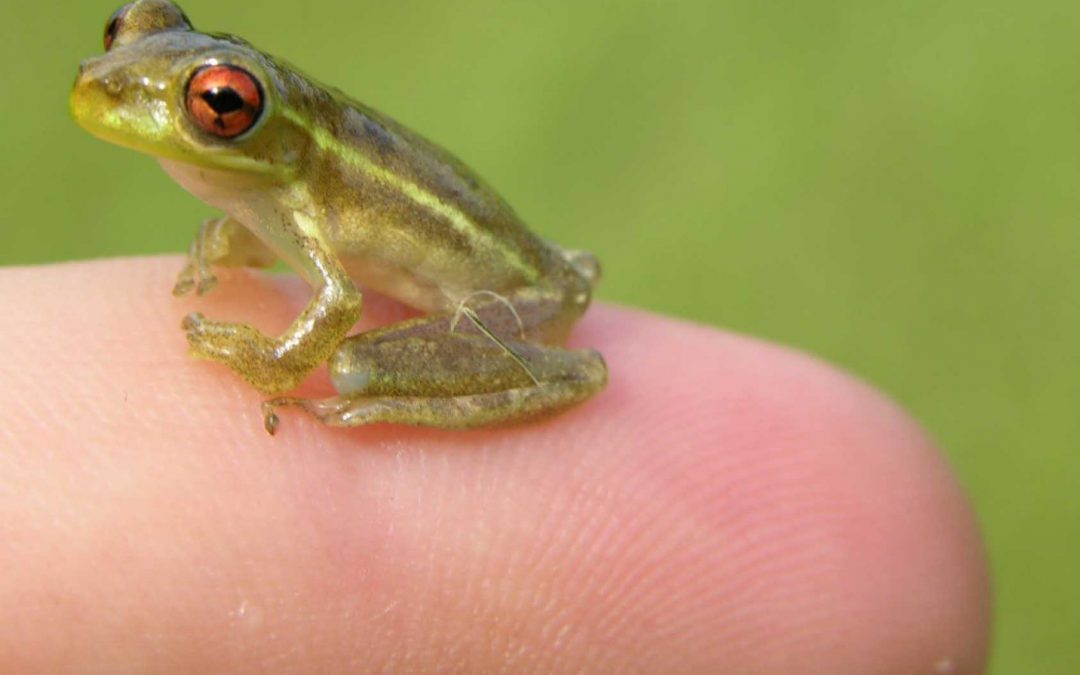
by Sheila Dunning | Jul 15, 2021
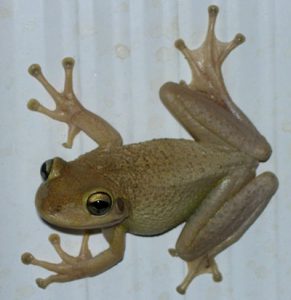
Photo by Dr. Steve Johnson
Treefrog calls are often heard with each rain event. But, how about a “snoring raspy” call that begins after a day time light rain? That may be a male Cuban treefrog trying to attract the girls. Cuban treefrogs breed predominately in the spring and summer. Reproduction is largely stimulated by rainfall, especially warm summer rains such as those associated with tropical weather systems and intense thunderstorms.
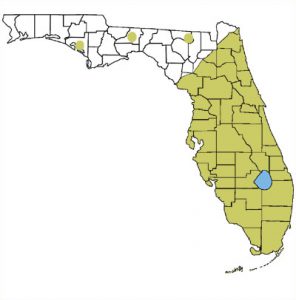
Range of Cuban treefrogs
The Cuban treefrog, Osteopilus septentrionalis, was accidently introduced to Florida in the 1920’s as a stowaway in shipping crates from the Caribbean. Over the last hundred years, the invasive frog has managed to spread throughout Florida and the Southeastern U.S. by hitchhiking on ornamental plants, motorized vehicles, and boats. Though occasional cold winters have created temporary population setbacks, new generations of Cuban treefrogs continue to be reported in north Florida, including the Panhandle.
An invasive species is generally defined as a plant, animal or microbe that is found outside of its native range, where it negatively impacts the ecology, economy or quality of human life. Cuban treefrogs come out at night to feed on snails, millipedes, spiders and a vast array of insects. But, they are also predators of several Florida native frogs, lizards and snakes. Tadpoles of the invasive Cuban treefrog have been shown to inhibit the growth and development of native Southern toad and green treefrog tadpoles when all of the species are in the same water body. Additionally, a large female Cuban treefrog can lay over 10,000 eggs per season in very small amounts of water.
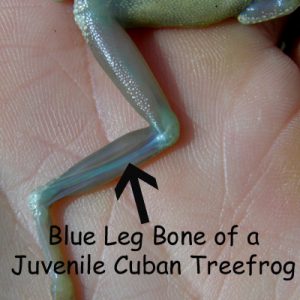 Panhandle citizens can help manage the invasive Cuban treefrog by learning to identify them and reduce their numbers. All treefrogs have expanded pads on the ends of their toes. Cuban treefrogs have exceptionally large toepads. They also have a “big eyed” appearance due to their oversized bulging eyes. Cuban treefrogs may exceed 6 inches in length, have warty-looking skin with possible blotches, bands or stripes, and vary greatly in color. However, they can be distinguished from other treefrogs. Cuban treefrogs have a yellowish wash where their front and rear legs are attached to their body. Juvenile Cuban treefrogs have red eyes and blue bones visible through the skin of their hind legs. The skin of the Cuban treefrog produces a sticky secretion that can cause a burning or itching sensation if it contacts the eyes or nose of certain individuals. It is recommended to wear gloves and wash your hands after handling Cuban treefrogs.
Panhandle citizens can help manage the invasive Cuban treefrog by learning to identify them and reduce their numbers. All treefrogs have expanded pads on the ends of their toes. Cuban treefrogs have exceptionally large toepads. They also have a “big eyed” appearance due to their oversized bulging eyes. Cuban treefrogs may exceed 6 inches in length, have warty-looking skin with possible blotches, bands or stripes, and vary greatly in color. However, they can be distinguished from other treefrogs. Cuban treefrogs have a yellowish wash where their front and rear legs are attached to their body. Juvenile Cuban treefrogs have red eyes and blue bones visible through the skin of their hind legs. The skin of the Cuban treefrog produces a sticky secretion that can cause a burning or itching sensation if it contacts the eyes or nose of certain individuals. It is recommended to wear gloves and wash your hands after handling Cuban treefrogs.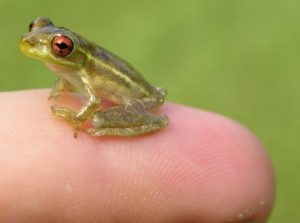
It is important to document the locations of Cuban treefrogs in the Panhandle. By placing short sections of PVC pipe in the ground around your home and garden will provide hiding places for treefrogs that enables you to monitor for Cuban treefrogs. Cut 10 foot sections of 1.5-inch-diameter PVC pipe into approximately three-foot-long sections and push them into the ground about 3-4 inches. To remove a frog from a pipe, place a clear sandwich bag over the top end, pull the pipe from the ground, and insert a dowel rod in the other end to scare the frog into the baggie. If you suspect you have seen one, take a picture and send it to Dr. Steve Johnson at tadpole@ufl.edu. Include your name, date, and location. Dr. Johnson can verify the identity. If it is a Cuban treefrog, upload the information by going to http://www.eddmaps.org/ and click the “Report Sightings” tab.
Once identified as a Cuban treefrog, it should be euthanized humanly. To do that, the Cuban treefrog in a plastic sandwich bag can be placed into the refrigerator for 3-4 hours then transferred to the freezer for an additional 24 hours. Alternatively, a 1-inch stripe benzocaine-containing ointment (like Orajel) to the frog’s back to chemically anesthetize it before placing it into a freezer. After freezing, remove the bagged frog from the freezer and dispose of in the trash. Ornamental ponds should also be monitored for Cuban treefrog egg masses especially after a heavy rain. The morning after a rain, use a small-mesh aquarium net to scoop out masses of eggs floating on the surface of the pond and simply discard them on the ground to dry out. Various objects that can collect water found throughout your yard need to be dumped out regularly to reduce breeding spots for both Cuban treefrogs and mosquitoes.
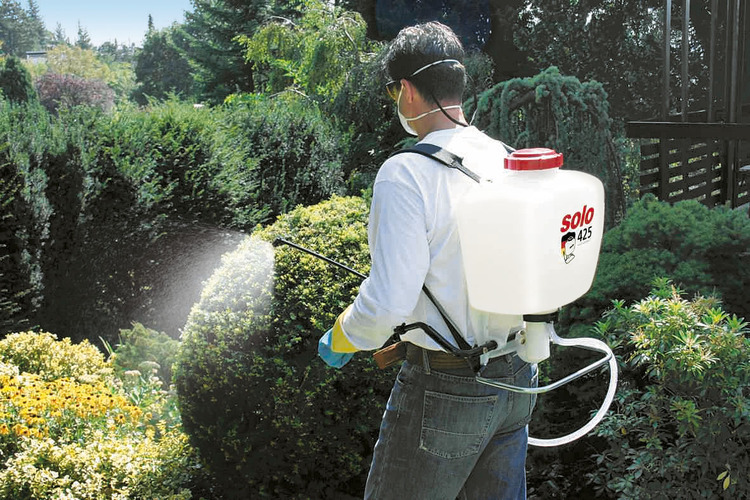
by Daniel J. Leonard | Jun 24, 2021
Nutsedge, commonly called “nutgrass”, is one of the most important and difficult to control weed pests in the world. Found in nearly every growing situation, from crop fields and vegetable gardens to landscapes and turfgrass lawns, I bet every person reading this has contended with controlling nutsedge at some point! Nutsedge (a common term to describe several species of weeds in the genus Cyperus) not only reduces curb appeal, but also h as a detrimental effect on desirable plantings around it. Because of its aggressive nature and dense root system, it competes heavily with “good” plants for water, light, and nutrients, causing the plants we are trying to grow to suffer. This is a weed that you definitely do not want in your lawn or landscape!
To keep nutsedge at bay, it’s important to know a few facts about it. First, “nutgrass” is not a grass at all, but a totally different class of plants known as sedges. This is important because selective herbicides used to kill grassy weeds will not affect nutsedge. Though they’re grass look-alikes, sedges can be distinguished by their distinctive triangular shaped stems. You can actually feel the three edges of nutsedge stems. If ever in doubt over whether a weed is a grass or a sedge, remember “sedges have edges”. Most sedges are perennials, dying back to the ground each year in winter and reemerging from tubers, called “nutlets”, that can survive over a foot under the ground! Also, while sedges generally prefer wet areas, they aren’t very particular about where they grow and are equally at home in sand or clay, wet or dry, and sun or shade. All these characteristics make sedges hard to control and cause much consternation amongst gardeners!
The first line of defense in controlling nutsedge is keeping a dense cover over any bare ground. In lawns, this means maintaining a thick, healthy turf as weeds love to enter lawns through thin or patchy areas. This can be accomplished by mowing regularly, fertilizing appropriately based on a soil test, not overirrigating while also not allowing the grass to suffer badly during droughty periods. Easier said than done. In landscape beds, preventative control is a little easier. First, as nutsedge prefers wet areas, only irrigate when it is needed. During much of the year, most established landscapes can get by on rainfall alone. Next, simply maintain a roughly 3” layer of pine straw, wood chips, pine bark, or other natural mulch of your choice. Doing so will reduce all manner of weeds, nutsedge included, and is generally beneficial for ornamental plants as well! I do not recommend landscape fabric as it is a pain to install and remove and is not extremely effective at reducing nutsedge as the sedge’s sharp growing points punch right through most plastic or fabric mulches.
Though mulching and other preventative measures can reduce nutsedge numbers, those methods alone are usually not enough and chemical herbicides are required. Fortunately, in Panhandle lawns and landscapes, there are several excellent, readily available options for sedge control: imazaquin and halosulfuron.
- Imazaquin is the active ingredient in the common product Image Kills Nutsedge and has good activity on most sedge species. It can be applied safely to all the common turfgrass species grown in the area and can even be sprayed right over the top of most common ornamental landscape plants!
- Halosulfuron is the active ingredient in the product Sedgehammer (available online or at specialty landscape supply stores) and several other generic products. Halosulfuron products provide excellent control of all nutsedge species and are safe to use in all turfgrass species found in Florida. While most landscape plants are tolerant of halosulfuron application, use care and try to only spray it on sedge weeds to avoid any unwanted yellowing or damage.
While both products begin working immediately, it may take several weeks to see sedge weeds start suffering and patience is necessary! Though both products are effective, follow up applications 3-4 weeks later are generally necessary to clean up any surviving sedge.
Nutsedge is a nasty little weed that can be difficult, though not impossible to manage. Through some smart cultural practices and timely applications of either imazaquin or halosulfuron, you can keep your lawn and landscapes nutsedge free! For more information about nutsedge control on your property or any other agricultural or horticultural topic, contact your local UF/IFAS County Extension office! Happy Gardening!
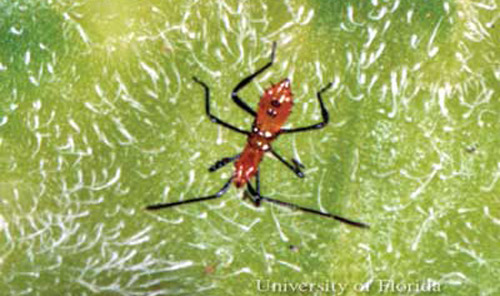
by Matthew Orwat | Mar 25, 2021
Stinkbugs and their relatives are not always problematic in the flower or vegetable garden, but when they become so, they can suck the life out of our fruits and vegetables, create ugly abrasions, and destroy flowers such as roses.
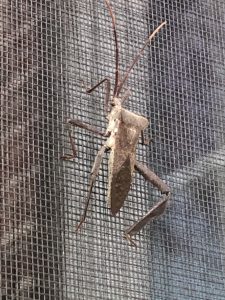
Over-wintering adult leaffooted bug emerging from hibernation . Image Credit Matthew Orwat, UF / IFAS Extension
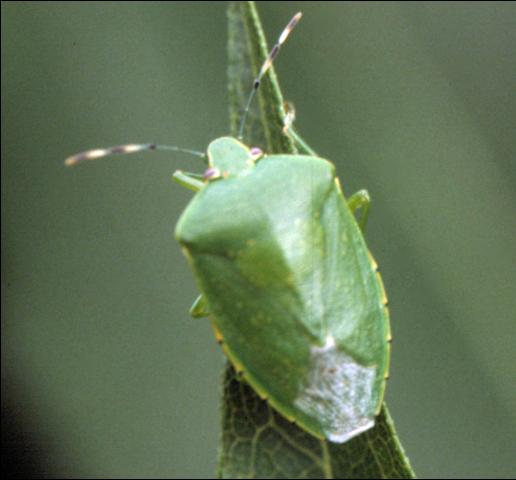
The green stink bug Acrosternum hilare (Say). Image and caption credit EDIS, Dr. Russ Mizell
What is a Stink Bug?
The stink bug (Pentatomidae family) is a major garden pest of a variety of fruits and vegetables including squash, peppers, tomatoes, peaches, plums, pecans and a variety of other edibles. They are known as a “piercing and sucking” insect because that’s the way they feed, by using their mouth, or proboscis, just like a needle to pierce the fruit and suck out the juices. This feeding leaves a damaged area of the fruit which may develop discoloration, rot or fungal disease and render the fruit unsaleable or inedible.
Who are “their relatives”
The leaf footed bug, Leptoglossus phyllopus (L), is a relative of the stinkbug and feeds in the same way, has a similar lifecycle and causes similar damage. They are usually slightly larger and have “leaf like” appendages on their legs which are their namesake.
What is their lifecycle?
In Florida, overwintering adult stink bugs will place a clutch, or tight group of eggs, on a host plant early in the growing season. If their preferred plant is not available, they use a variety of weeds and grasses to lay eggs upon and provide food for their young. After eggs hatch, they go through several nymph stages before they finally reach the adult stage. Stink bugs have multiple generations in a year, often four to five. They readily move to find preferable food sources and might appear in a garden without warning to feed and cause destruction.

Nymph of the leaffooted bug, Leptoglossus phyllopus (L.). Photograph by Lyle J. Buss, University of Florida.
How are they best controlled?
First of all, many stink bugs use weeds as host plants to gather and feed upon, so controlling weedy plants around vegetable and fruit gardens might limit their numbers. If stink bugs are a major problem, planting trap crops, such as sunflowers, is beneficial. Stink bugs prefer to feed on sunflowers more than some other vegetables. This situation can be used to the gardener’s advantage by mechanically killing or spraying stink bugs on trap crops while avoiding treating food crops with pesticides. More information on trap cropping can be found here.
Additionally, stink bug traps are available. These mechanically trap stink bugs, thus reducing their numbers in the garden, but need to be monitored and serviced regularly. Several species of parasitic Tachinid flies are also predators of stink bugs. These flies lay their eggs on adult stink bugs. The fly larva use the bug as a buffet, slowly killing the bug.
Stink bugs are difficult to control with insecticides, but some measure of control can be achieved at their nymph stage with various approved fruit and vegetable insecticides containing pyrethrins. These products are readily available at local garden centers and feed & seed stores.
For more information, please check out the following resources:














